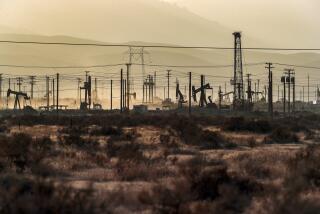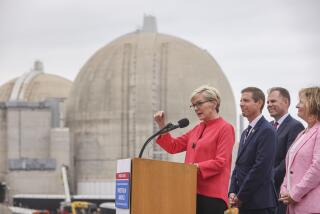Rockwell Proposes Natural Gas Research Lab : Energy: Under company’s proposal, new uses would be found for the $1-billion Santa Susana facility. Federal funding is critical.
- Share via
Faced with major cutbacks in federal funding, Rockwell International officials are scrambling to convert a portion of their Santa Susana Field Laboratory near Simi Valley into a major center that would develop new uses for natural gas.
Rockwell officials have proposed establishing the natural gas test center on 230 acres within the high-security lab located in the hills southeast of Simi Valley. The site, known as the Energy Technology Engineering Center, is now used to test non-nuclear components for atomic reactors. Rockwell conducts the tests for the U.S. Department of Energy.
For the record:
12:00 a.m. May 19, 1993 For the Record
Los Angeles Times Wednesday May 19, 1993 Valley Edition Metro Part B Page 3 Column 5 Zones Desk 1 inches; 34 words Type of Material: Correction
Rockwell picture--A photograph Saturday misidentified two men in the control room at Rockwell International’s Energy Technology Engineering Center. The men were shift supervisor John Jackson and operations engineer Ralph Sinclair.
But the future of the center’s operations is threatened by budget cuts, at a time when few nuclear power plants are being built around the world.
To prepare for the future, Rockwell executives said they have opened negotiations with the Southern California Gas Co. and are already working on at least two potential natural gas projects. Under proposals being considered, a natural gas test facility would be operated in partnership with the federal government, Southern California Gas Co. and other major utilities in the state.
“What we’re really focused on right now is keeping this place operating,” said Clark Gibbs, Rockwell’s general manager of energy programs.
Budget cuts proposed by the Clinton Administration could eliminate 115 of the 185 Rockwell employees who work in the energy technology center on the 230-acre complex at the western edge of 2,700-acre lab site. Much of the lab is used by Rockwell to test rockets for NASA and other agencies.
Since the late 1970s, Rockwell has run the energy technology center mainly to test materials and equipment used in the building of nuclear power plants. When the center first began operating, its work force numbered more than 500.
But the slowdown in the construction of nuclear power plants worldwide has forced Rockwell to scale back operations at the center.
If the budget cuts take place, officials say the center would be reduced to only about 60 employees or possibly shut down altogether.
“Right now we’re preparing for a phaseout,” said John Belluardo, a spokesman for the Energy Department’s San Francisco operations office. Still, Belluardo said the department is talking with Rockwell officials about other possible uses for the energy technology center, including the natural gas project.
Belluardo said the government has a strong interest in promoting conservation and to advance the uses of natural gas. But given budget constraints, he said, it’s too early to say if it will support Rockwell’s proposal.
“Anything’s possible,” he said. “Rockwell is being very aggressive in trying to find other possible alternatives” for the center.
Rep. Elton Gallegly (R-Simi Valley), whose district includes the Santa Susana lab, said he has already begun lobbying to keep the energy technology center operating.
Gallegly said he sent a letter earlier this week to the House Appropriations subcommittee on energy and water in support of establishing a natural gas test facility at Santa Susana. He noted that the government has about $1 billion worth of equipment and test facilities at the site and that it would be a waste to shut it down.
“If we can keep it open, I think that is in the best interest of the country,” Gallegly said. “My greatest concern is in maintaining jobs and the investment of taxpayers.”
Gibbs said the nation, which has an abundant supply of natural gas, has a strong environmental interest in finding more uses for the clean-burning fuel.
He noted that natural gas-powered automobiles, which emit less oxides of nitrogen and sulfur than regular gasoline, are already available on the market.
Gibbs said the energy technology center could be used to develop other uses for natural gas. For example, he said there is a great need to create more efficient and less polluting natural gas-powered generators to produce power for utilities.
Hank Wieseneck, vice president of Rockwell’s energy programs, said it’s important that the government play a role in helping American companies develop these new technologies.
“If you want to see your bigger industries be competitive and go out with innovations and get some of the world markets, then this is a place where the government can really parlay its investment,” Wieseneck said.
Gibbs said he hopes to see the energy technology center become a national test center site that would be used by a wide range of private and public companies to test new products.
He said the Japanese government has already created such a place in Tsukaba--Japan’s science city--located about 35 miles north of Tokyo. Japan has built a 6,500-acre development and test site there that is used by industries to test new products.
“We’re no longer a world of nations with individual companies in competition,” Gibbs said. “We’re a world of nations in competition with one another.”
Rockwell’s Field Laboratory Areas 1-111: Used for rocket testing by NASA and other agencies. Area IV: 230-acre site now leased by the U.S. Department of Energy, which contracts with Rockwell to operate its Energy Technology Engineering Center.
More to Read
Sign up for Essential California
The most important California stories and recommendations in your inbox every morning.
You may occasionally receive promotional content from the Los Angeles Times.










